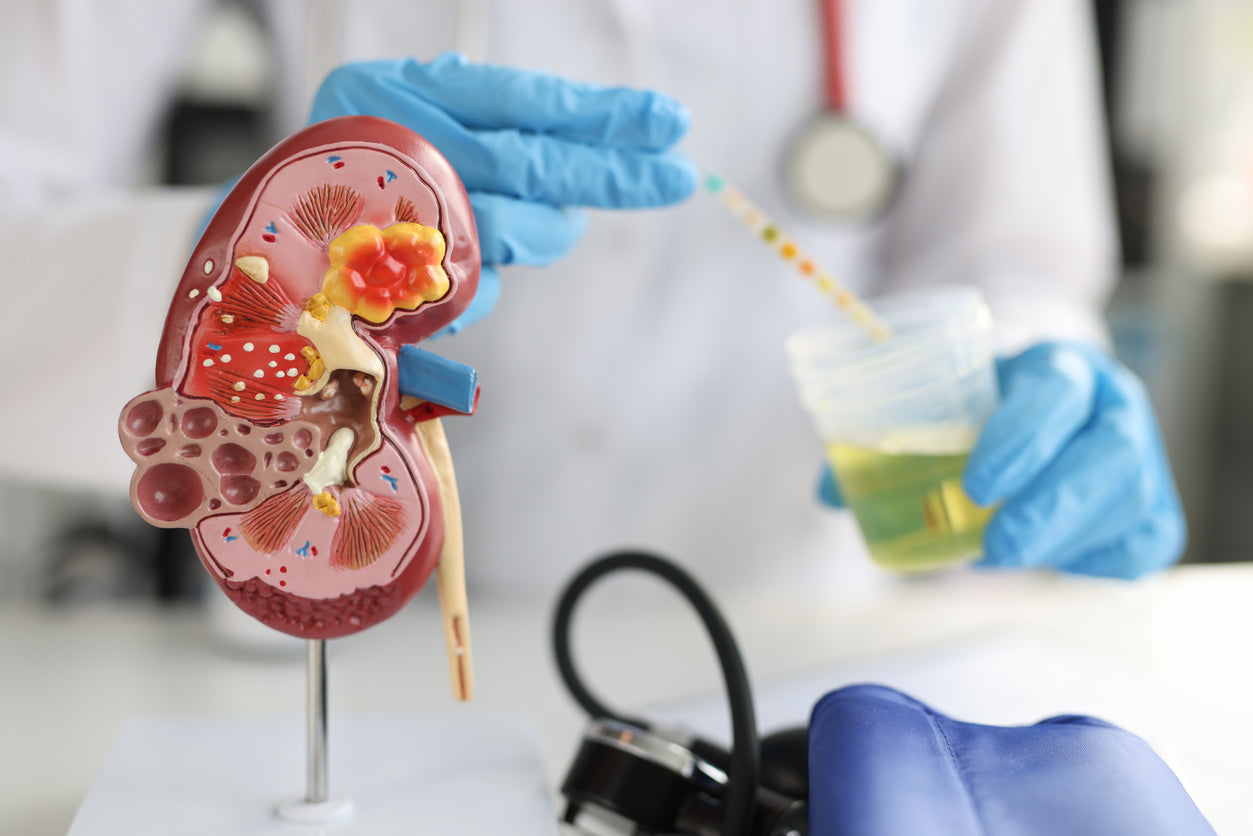Medically reviewed by Dr. Temitope Rude, MD
If you’re experiencing oily urine, you may start wondering about its cause and whether concern is warranted regarding this recent change. This article delves into an examination of 7 common factors contributing to oily urine, shedding light on signs that may indicate a more serious underlying issue.
What is Oily Urine?
Oily urine refers to the appearance of an oil-like sheen or film on the surface of urine. It is not a specific medical condition but rather a symptom or observation that may have various underlying causes. The causes of oily urine can range from harmless to requiring medical attention.
Is Oily Urine Normal?
While variations in urine composition can be attributed to a range of factors, the presence of oiliness may raise questions about its typicality. In general, urine is expected to be clear and devoid of noticeable oil-like substances.
However, occasional deviations can be influenced by various factors such as dietary choices, hydration levels, and even specific medications which we will cover next. Nonetheless, persistent or recurring oily urine should prompt closer attention, as it may signify an underlying health issue.

7 Common Causes of Oily Urine
Although urine is generally expected to be free from any oil-like appearance there are some factors that can contribute to an oily appearance that are not necessarily dangerous. For example, occasional deviations can be influenced by various factors such as dietary choices, hydration levels, and even specific medications. For this reason, it is crucial to consider individual differences and circumstances. Below we will cover 7 common causes of oily pee in more detail.
1. Dehydration
Dehydration can manifest in various ways, and one lesser-known indication is the potential for urine to become oily. When the body experiences insufficient fluid intake, it responds by conserving water, leading to concentrated urine. This concentration can result in the excretion of substances that might not be as diluted as they should be, potentially giving the urine an oily-colored appearance.
Inadequate hydration can compromise the kidneys' ability to effectively filter and eliminate waste products, allowing certain substances to accumulate in the urine. As a consequence, dehydration can contribute to the appearance of oily urine, serving as a physiological response signaling the need for increased fluid intake to maintain proper bodily functions and overall health.
2. Ketosis
Ketosis, a metabolic state characterized by the increased production of ketone bodies, can give rise to oily urine. During ketosis, the body shifts from relying on carbohydrates for energy to utilizing stored fat, leading to the breakdown of fatty acids. As a result, ketones are produced and excreted through urine.
The presence of ketones in the urine, a phenomenon known as ketonuria, can sometimes impart an oily or fruity scent to the urine. This occurrence is particularly associated with low-carbohydrate, high-fat diets, such as the ketogenic diet. While ketosis is a normal metabolic process, persistent or excessive ketone excretion may warrant monitoring, as it could be indicative of an imbalance or inadequate hydration. This may also result in a change of color in the urine.
It is advisable for individuals undergoing ketosis, whether through dietary choices or medical conditions, to stay adequately hydrated and consult healthcare professionals for guidance on maintaining a healthy metabolic state.

3. Certain foods
Certain dietary choices can contribute to the development of oily pee. Consumption of foods high in fats, particularly those rich in unsaturated fats and omega-3 fatty acids, may result in an oily appearance in the urine.
Foods such as fatty fish, nuts, seeds, avocados, and olive oil, which are commonly part of a healthy diet, can occasionally lead to the excretion of oily substances in the urine. Additionally, an excess intake of certain supplements, such as fish oil capsules or omega-3 supplements, may also contribute to this phenomenon.
While these dietary factors may lead to temporary changes in urine composition, it is essential to differentiate between benign occurrences and potential underlying health issues. Monitoring dietary habits and consulting with healthcare professionals can help individuals gain a better understanding of the relationship between food choices and urine characteristics.
4. Water-Soluble Vitamins
Water-soluble vitamins, such as vitamin B-complex and vitamin C, are generally excreted through urine when present in excess in the body. In some instances, the elimination of these water-soluble vitamins can lead to changes in urine consistency, including the appearance of oiliness.
This occurrence is not typically a cause for concern, as the body tends to expel excess water-soluble vitamins through urine when they surpass the body's requirements. In particular, high doses of certain vitamin supplements, often taken for health or nutritional purposes, can contribute to this phenomenon.
Despite the temporary alteration in urine characteristics, it is important to note that water-soluble vitamins are generally considered safe and essential for bodily functions. Nevertheless, individuals experiencing persistent or unusual changes in urine should seek advice from healthcare professionals to rule out any potential underlying issues and ensure optimal health.
5. Pregnancy
During pregnancy, hormonal and physiological changes in the body can influence various aspects of health, including urinary patterns. Oily urine during pregnancy may be attributed to a combination of factors. Increased hormonal activity and changes in metabolism can alter the composition of urine, potentially leading to changes in the the appearance of urine.
Additionally, prenatal vitamins, which are commonly prescribed during pregnancy, may contain fat-soluble components that can contribute to changes in urine texture. It's essential for pregnant individuals to maintain proper hydration throughout their pregnancy to support overall health and ensure adequate urine dilution.
While mild changes in urine consistency are often considered normal during pregnancy, any persistent or concerning alterations should be discussed with healthcare professionals to rule out potential complications and ensure the well-being of both the expectant parent and the developing fetus.
6. Some Medications
Certain medications have the potential to influence urine composition, and the appearance of oily urine can be associated with specific drug interactions or side effects. Medications that contain or affect fat metabolism may contribute to changes in urine texture.
For instance, certain lipid-lowering medications, such as fibrates, may impact fat metabolism and lead to the excretion of fatty substances in the urine. In addition, supplements like fish oil capsules, commonly taken for their omega-3 fatty acids, may also contribute to the oily appearance of urine. It is crucial for individuals taking medications associated with such effects to be aware of potential changes in urine characteristics.
Consulting with healthcare professionals about any observed changes is essential to discern between harmless occurrences and potential signs of underlying health issues, ensuring a comprehensive understanding of medication-related effects on urine.

7. Urinary Tract Infections (UTI)
Urinary Tract Infections (UTIs) are commonly associated with changes in urine characteristics, and although oily urine is not a classic symptom of UTIs, certain factors related to these infections might influence urine appearance. UTIs are primarily caused by bacterial overgrowth in the urinary tract, leading to inflammation and potential alterations in urine composition.
In some cases, the presence of mucus or pus in the urine, which can occur with UTIs, may impart an unusual texture that could be perceived as oily. Additionally, the overall inflammatory response in the urinary tract during a UTI may contribute to changes in urine appearance.
While UTIs typically present with more recognizable symptoms like frequent urination, pain, or a strong urge to urinate, any persistent or unusual changes in urine should be discussed with healthcare professionals for a comprehensive evaluation and appropriate management of potential underlying issues. If you struggle with frequent UTIs, try our UTI Defense Daily Supplement
Characteristics of Oily Urine
Oily urine is characterized by distinct physical traits that can make it stand out from normal urine. These characteristics primarily include changes in its appearance, texture, and odor, which may provide clues about its underlying causes.
Appearance and Texture
Oily urine typically features a thin, reflective sheen or a slick film on its surface, often creating a rainbow-like effect under light. In some cases, small droplets resembling oil may float on the surface. While urine is naturally a liquid, oily urine may seem slightly thicker or leave a subtle residue when observed.
Odor
The odor of oily urine can vary significantly, from being mild to noticeably strong or unusual. A strong or pungent smell may result from specific foods, medications, or infections. If the odor is persistent or particularly unpleasant, it might indicate the need for medical evaluation.
Oily Urine and Underlying Health Conditions
While dietary factors, medications, and transient physiological states may account for some instances of oily urine, persistent or recurrent occurrences may be the result of underlying health conditions.
Liver Disorders
Liver disorders can potentially contribute to the development of oily urine due to disruptions in the body's metabolism and processing of fats. The liver plays a crucial role in producing bile, which aids in the digestion and absorption of dietary fats. When the liver is impaired, as seen in conditions like fatty liver disease or liver cirrhosis, the breakdown and processing of fats may be compromised. Consequently, excess fats can be excreted through urine, resulting in an oily appearance.
Liver disease, also known as bilirubinuria, is frequently known to cause deep yellow or orange oily urine in addition to other symptoms. Additionally, other diseases of the liver such as hepatitis and fatty liver disease, as well as damage from drug and alcohol use can cause oily urine.
Liver disorders often manifest with a range of symptoms, and while oily urine is not a standalone diagnostic marker, its presence alongside other indicative signs may prompt further investigation. Individuals experiencing persistent changes in urine texture, especially in conjunction with other liver-related symptoms, should promptly seek medical attention for a comprehensive evaluation and appropriate management of potential liver disorders.
Pancreatic Conditions
Pancreatic conditions, particularly those affecting the exocrine function of the pancreas, can contribute to the development of oily urine. The pancreas plays a crucial role in the secretion of digestive enzymes, including lipase, which aids in the breakdown of fats. Conditions such as chronic pancreatitis or pancreatic insufficiency can lead to inadequate production of these enzymes, impairing the proper digestion and absorption of fats. As a result, undigested fats may pass into the bloodstream and be excreted in the urine, giving it an oily or greasy appearance. This occurrence, known as steatorrhea, is characterized by the presence of excess fat in feces and urine.
Individuals experiencing persistent oily urine along with other symptoms indicative of pancreatic disorders, such as abdominal pain or digestive issues, should seek prompt medical attention for a comprehensive evaluation and appropriate management.

Kidney Issues
Kidney dysfunction can potentially contribute to the development of oily urine. The kidneys play a vital role in filtering waste products from the blood, maintaining fluid balance, and ensuring the proper excretion of metabolic byproducts. When kidney function is compromised, as seen in conditions like nephrotic syndrome or certain glomerular diseases, the filtration process may be disrupted. This can lead to the presence of abnormal substances, including fats, in the urine. The accumulation of lipids in the urine, known as lipuria, can impart an oily appearance.
Some conditions that may present with oily urine are polycystic kidney disease, kidney stones, ketoacidosis, and chyluria.
While kidney dysfunction typically presents with more overt symptoms such as changes in urine volume, color, or the presence of blood, any persistent or unusual alterations in urine texture should be promptly addressed with healthcare professionals for a thorough evaluation of kidney health and appropriate treatment.
Malabsorption Syndromes
Malabsorption syndromes, characterized by the impaired absorption of nutrients in the digestive tract, can contribute to the development of oily urine. Conditions such as celiac disease, Crohn's disease, or pancreatic insufficiency can disrupt the normal digestion and absorption of fats.
In the absence of proper fat absorption, undigested fats may be excreted through urine, resulting in an oily or greasy appearance. This phenomenon, known as steatorrhea, can be accompanied by other symptoms like diarrhea, weight loss, and nutrient deficiencies. Individuals with malabsorption syndromes may experience a range of digestive issues, and the presence of oily urine can be an additional sign of the underlying absorption difficulties.
Timely consultation with healthcare professionals is crucial for a comprehensive evaluation, diagnosis, treatment, and management of malabsorption syndromes to address both the primary condition and associated symptoms.
Metabolic Disorders
Metabolic disorders, encompassing a diverse range of genetic conditions affecting the body's normal biochemical processes, can contribute to the manifestation of oily urine. Certain metabolic disorders, such as lipid metabolism disorders, may disrupt the breakdown and utilization of fats. Consequently, excess lipids may be excreted through urine, leading to an oily appearance.
Disorders like lipoprotein lipase deficiency or certain types of lipid storage diseases can impact the body's ability to process fats effectively. The presence of oily urine in individuals with these disorders may be indicative of an underlying imbalance in lipid metabolism.
Given the systemic nature of metabolic disorders, comprehensive medical evaluation and ongoing management are essential to address the root cause of the disorder, manage symptoms, and optimize overall health.

Diabetes
In diabetes, particularly when blood sugar levels are consistently elevated, the condition can contribute to changes in urine composition, potentially leading to the presence of oily substances. Prolonged high blood sugar levels can result in damage to the kidneys over time, impairing their ability to filter and reabsorb substances efficiently. This dysfunction can lead to the excretion of excess lipids, causing the urine to appear oily.
Furthermore, individuals with diabetes may be at an increased risk of developing diabetic nephropathy, a kidney complication characterized by protein leakage into the urine. While oily urine is not a direct symptom of diabetes, the associated kidney damage can contribute to changes in urine texture.
Regular monitoring of blood sugar levels and routine healthcare check-ups are essential for individuals with diabetes to manage complications, including those affecting kidney function, and maintain overall health.
Hyperthyroidism
Hyperthyroidism, an endocrine disorder characterized by an overactive thyroid gland, can influence various metabolic processes in the body, potentially leading to the presence of oily substances in the urine. The accelerated metabolic rate associated with hyperthyroidism may enhance the breakdown of fats, resulting in an increased excretion of lipids through urine.
While oily urine is not a direct or common symptom of hyperthyroidism, the systemic effects of this condition on metabolic pathways can contribute to changes in urine composition. Individuals with hyperthyroidism often experience a range of symptoms related to increased metabolism, such as weight loss, sweating, and rapid heartbeat.
Monitoring thyroid function through blood tests and seeking medical guidance are crucial for individuals with hyperthyroidism to manage their condition effectively, prevent complications, and address associated symptoms.
Understanding Changes in Urinary Consistency
Changes in urinary consistency can be influenced by a variety of factors, ranging from hydration levels to underlying health conditions. Understanding what constitutes normal and abnormal urine characteristics, as well as how lifestyle and diet impact these changes, is essential for maintaining overall health.
Normal vs. Abnormal Urine Characteristics
Normal urine is typically clear to pale yellow, with a watery consistency and mild odor. Abnormal urine may appear cloudy, oily, or frothy, and it might be accompanied by a strong or unusual smell. These changes can indicate dehydration, infections, or other medical conditions requiring further evaluation.
Impact of Lifestyle and Diet
Diet and lifestyle choices significantly influence urinary consistency. High-fat meals, certain supplements, or a lack of proper hydration can lead to noticeable changes, such as oily or concentrated urine. Monitoring these factors and adjusting habits can often resolve minor changes, while persistent issues may signal the need for medical advice.
Warning Signs & When to See Your Doctor
Understanding the warning signs associated with changes in urine composition, such as the presence of oily substances, is crucial for maintaining health. While occasional variations may stem from benign causes, persistent or severe changes require attention.
Symptoms that Accompany Oily Urine
Oily urine may be accompanied by other symptoms that signal a need for medical evaluation. These can include abdominal pain, frequent urination, or unusual urine color that persists for several days. More concerning systemic symptoms, such as unexplained weight loss, fatigue, or persistent gastrointestinal issues, may point to underlying health conditions and should not be ignored.
Diagnostic Tests and Procedures (What to Expect at the Doctor)
If you seek medical attention for changes in urine consistency, your doctor may perform a thorough evaluation. This typically includes a detailed health history, physical examination, and diagnostic tests such as urinalysis to check for infections, protein levels, or other abnormalities. In some cases, blood tests or imaging studies may be recommended to rule out more serious underlying conditions. Early detection and treatment can significantly improve outcomes and support long-term well-being.

Dr. Temitope O. Rude is a Clinical Assistant Professor at Stanford Urology. Dr. Rude received her B.A. in Neurobiology at Harvard University, and her MD from Stanford University. She completed her urology residency at New York University, followed by a fellowship in Female Pelvic Medicine and Reconstructive Surgery (FPMRS) at USC in 2020. Her research focuses on improving patient-reported outcomes post-surgery for pelvic organ prolapse, alongside groundbreaking work in the medical and surgical management of neurogenic bladder and complex voiding dysfunction.
Sources:
Cleveland Clinic. (2022, June 27). Ketones in Urine During Pregnancy. https://my.clevelandclinic.org/health/symptoms/23157-ketones-in-urine-during-pregnancy
Hoilat GJ, John S. Bilirubinuria. [Updated 2023 Aug 8]. In: StatPearls [Internet]. Treasure Island (FL): StatPearls Publishing; 2023 Jan-. Available from: https://www.ncbi.nlm.nih.gov/books/NBK557439/
Kumar, Sonal. (2022, Aug). Overview of Chronic Hepatitis. Merck Manual. https://www.merckmanuals.com/home/liver-and-gallbladder-disorders/hepatitis/overview-of-chronic-hepatitis
Duncan KA, Cuppage FE, Grantham JJ. Urinary lipid bodies in polycystic kidney disease. Am J Kidney Dis. 1985 Jan;5(1):49-53. doi: 10.1016/s0272-6386(85)80136-0. PMID: 3966470.










